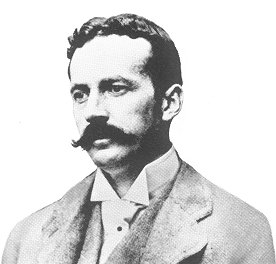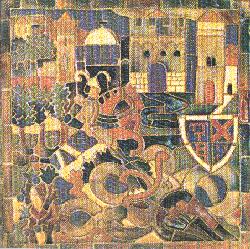|
Henry Chapman Mercer |
||
Henry Chapman Mercer was a master craftsman, but not by original intent. He was born in 1856 in Doylestown, Pennsylvania to old Quaker stock, and was trained as a lawyer to follow in the footsteps of his maternal grandfather, a prominent judge in that community. Mercer became an archaeologist instead, then a collector of American Pioneer handicraft tools, and after the age of thirty, a ceramist. An idealizer of the past, much as William Morris had been, Mercer became enamored of Pennsylvania-German pottery processes of the previous century. In an effort to resuscitate this lost art, Mercer turned his attention to pottery making. In 1898, he founded the Moravian Pottery and Tile Works in Doylestown, named after the Moravian cast-iron stove plates from which he derived his first designs for ceramic tiles. Moravian Tiles became his chief product and are unlike any others made before or since. They are pictorial storybook tiles, hand-crated, sometimes glazed in bright colors, but often left unglazed to give a free unbounded value to the red clay from which they are made. They became very popular with Arts and Crafts architects across the country who used them as fireplace facings and pavings. Ward Wellington Ward used more Moravian Tiles than any other architect in America, in all, over 200 installations in houses in upper New York State.
Mercer's tile designs were meant to tell a story and his varied themes reflected his interests and experiences in the fields of archaeology, literature, folklore, history, and the study of tools. They were sometimes adaptations, in his own fashion, of tile designs of the past. The result was a picturesque product: each Moravian Tile installation was unique. Some were made of plain geometric shaped tiles arranged in patterns for pavings and as backgrounds for picture tiles; others were pressed counter-reliefs or backgrounds for picture tiles; others were pressed counter-reliefs of silhouettes set widely in groups in backgrounds of mortar to form larger designs or pictures; and still others were mosaics made of colored clays to give the effect of stained glass. The fireplace Ward placed in the inglenook for frank Garret (Syracuse, 1913) depicting St. George and the Dragon (see below) is an original tile mosaic mural made by Mercer to satisfy Ward's requirement for a "picture-book, English castle, tapestry effect." Mercer gained recognition for other activities besides those of Arts and Crafts ceramics. His original findings in the field of archaeology, his pioneering development of museum concepts, his contributions to the study of American tools, and his innovative building with reinforced concrete are among the major achievements of his lifetime. He died in 1930, leaving a vast legacy of papers and artifacts which have yet to be fully appreciated.
(Excerpted from The Arts & Crafts Ideal: The Ward House, an Architect & His craftsmen by Cleota Reed. The institute for the Development of Evolutive Architecture, Inc., Syracuse, New York. 1978) |

